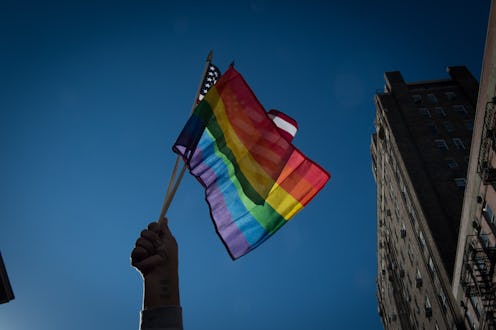Life
The Rainbow Flag Will Permanently Fly On Federally-Funded Land For The First Time Ever

On Wednesday, Oct. 11, the Stonewall National Monument in NYC will get a special addition: the rainbow flag, flying above it permanently. This will be the first time in America's history that the LGBTQ flag is installed as a fixture on federal land, and it's a huge deal. Hopes for LGBTQ rights in the U.S. at the moment aren't exactly at a high, so the installation of a permanent rainbow flag fluttering above a national monument 24/7 represents a hugely historic moment that goes far beyond the symbolism of the flag itself.
Stonewall National Monument is the first American monument to be dedicated to LGBTQ rights, and is named for the nearby Stonewall Inn, which was at the center of the famous Stonewall riots of 1969 that is widely considered the kickoff of the gay rights movement in America. Nearly 50 years later, the advent of the rainbow flag on federal land is meant to represent how far things have come since the riots. The pride flag, designed as a symbol for the gay community by the late artist Gilbert Harvey at the request of gay politician Harvey Milk in 1978, has presided over many great moments in the queer rights movement, but its enshrinement on federal land is meant to remind us of how hard-fought those rights were, and how dangerous America remains for many gay, queer, bisexual, asexual and transgender people.
Why A Monument To Gay Rights Matters Now
While some federal buildings across the U.S. aren't exactly strangers to the rainbow colors — the White House was lit with rainbow colors to celebrate the passing of marriage equality in the Supreme Court in 2015 — the permanence of this gesture is groundbreaking.
AIDS activist Michael Petrelis, who's been a key part of the movement around the Stonewall monument's installation, said in a statement provided to Bustle, “It is a victory for our community to have these symbolic colors flying majestically over our Stonewall, designated as a National Monument by President Obama, even as our LGBTQ brothers and sisters are under attack by the current regime in power." The context of the flag's unveiling, as Petrelis alluded to, isn't a positive one. Under President Trump, the White House refused to acknowledge National Pride Month, has removed guidance on transgender bathrooms in schools, and won't ask questions about LGBTQ status on the 2020 Census. The government also, in what the New York Times called "three punches in one day" in July 2017, expressed the view that sex discrimination laws in employment don't cover sexual orientation, banned transgender people serving in the military, and appointed anti-gay governor Sam Brownback as "ambassador for religious freedoms."
The choice of Oct. 11 for the raising of the permanent rainbow flag is deliberate, and super meaningful. It marks 30 years since the 1987 March On Washington for Lesbian Gay Rights, in which 200,000 people descended on the National Mall to call for more funding for AIDS research from the Reagan government, unfurled the now-famous AIDS Quilt, and protest for better rights for the LGBTQA community. "We are reminded of another October 11, thirty years ago, when the names of fallen comrades were symbolically celebrated on another national monument — the AIDS Quilt — during the reign of another President who waged and attack against us," Petrelis said. Decades on, HIV continues to be much more common in gay and bisexual men than in any other segment of the population, though medical treatments have now meant many people can live long, healthy lives with an HIV diagnosis.
Permanent Pride Is Needed In 2017
While Gilbert Baker himself died in 2017, his flag has become the symbol of queer and gay rights around the world, from Pride parades to protests. The National Monument's permanent installation of the rainbow colors is a pretty symbolic moment, implying that the rights of the LGBTQ community and their struggle to obtain them are an important and visible part of American history that deserves to be known and celebrated. As this is in many ways an unsettling time for LGBTQ people across the U.S., the visibility of the flag makes a powerful statement: their voices are not going away.
But flags on monuments are, alas, also not enough. The U.S. just voted against a UN resolution condemning the death penalty in countries where it is illegal to be gay (though it's notable that the reasoning given was because of the U.S.'s support for the death penalty, not because of support for anti-gay regimes). The resolution passed regardless, but the stance of the U.S. wasn't missed by international observers or by LGBTQ activists in America. Huge numbers of participants at this year's Gay Pride marches across America earlier this year show that the LGBTQ community is aware of the dangers and mobilizing to protest a government that's endangering its rights. The Stonewall Monument flag is a celebration, but it's also a call to action.